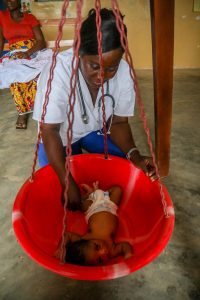
Baby Alex, two days old, is weighed by Alice the midwife in White Plains Clinic, Liberia. Alex was named after Alice who delivered him.
Maternal, fetal, and neonatal health outcomes are interdependent. Designing public health strategies that link fetal and neonatal outcomes with maternal outcomes is necessary in order to successfully reduce perinatal and neonatal mortality, particularly in low- and middle- income countries. However, to date, there has been no standardized method for documenting, reporting, and reviewing facility-based stillbirths and neonatal deaths that links to maternal health outcomes would enable a more comprehensive understanding of the burden and determinants of poor fetal and neonatal outcomes.
We developed and pilot-tested an adapted RAPID tool, Perinatal-Neonatal Rapid Ascertainment Process for Institutional Deaths (PN RAPID), to systematically identify and quantify facility-based stillbirths and neonatal deaths and link them to maternal health factors in two countries: Liberia and Nepal.
This study found an absence of stillbirth timing documented in records, a high proportion of neonatal deaths occurring within the first 24 hours, and an absence of documentation of pregnancy-related and maternal factors that might be associated with fetal and neonatal outcomes. The use of an adapted RAPID methodology and tools was limited by these data gaps, highlighting the need for concurrent strengthening of death documentation through training and standardized record templates.